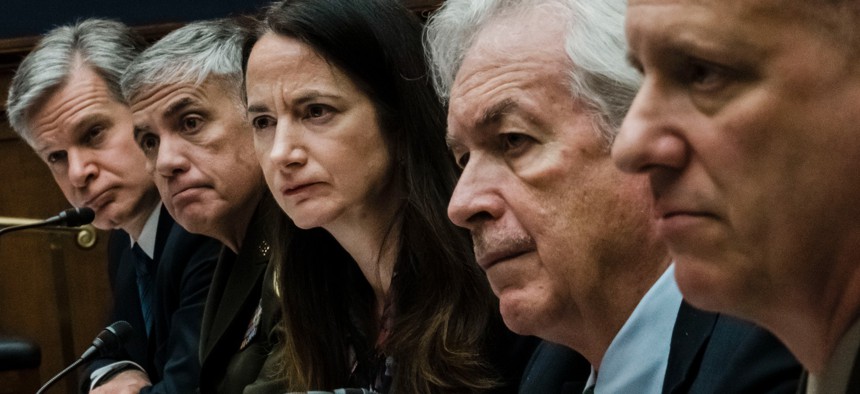The IC's 4-year emerging tech investment plan

The heads of the intelligence community, FBI Director Christopher Wray, NSA Director Gen. Paul Nakasone, Director of National Intelligence Avril Haines, CIA Director William Burns and DIA Director Lt. Gen. Scott Berrier, testify at a House hearing on March 8, 2022. Kent Nishimura / Los Angeles Times via Getty Image
The Office of the Director of National Intelligence's investment strategy aims to make it easier for companies to connect with program managers.
The intelligence community wants to invest heavily in emerging technologies to solve problems like being able to identify improvised explosive devices and their respective networks. But to better ensure its needs are met, the Office of the Director of National Intelligence mapped out a four-year investment strategy to make it easier for companies to connect with program managers.
The ODNI's Science and Technology Investment Landscape document for fiscal years 2022 through 2026 marks a shift in how the intelligence community looks to track technologies research by making them more traceable not only to missions but to who on the government side owns the challenge and whether or not they will have to work with other program managers within the IC or across government.
"To best posture the U.S. Intelligence Community to meet future challenges, today's decision makers must anticipate over-the-horizon threats to our national security and marshal an integrated, collaborative, and systematic approach to driving community investment in science and technology," said Dustin Gard-Weiss, the ODNI's deputy director of national intelligence for policy and capabilities.
Some needs cross multiple areas of expertise, and seem to be heaviest in artificial intelligence, data, cyber, computing and sensor capabilities. Those needs span from more basic analytic tools or methods that can be applied across the community, such as developing three- or four-dimensional data visualization capabilities or techniques to mitigate bias in machine learning, to more complex ones that require participation from other government agencies and departments, like developing tools that can "rapidly discover and analyze highly diluted information on social media" or assist with satellite interference detection or help identify supply chain vulnerabilities.
Desired investments skew towards needs that require coordination from multiple program managers, according to the document. Those include developing and improving capabilities to detect cyber compromises and machine learning for computer network defense, improving the ability to electronically shield signals, being able to link media to its genesis or author, and developing ways to "apply nontraditional biometric signatures to entity resolution.
Single program manager needs had the shortest list and ranged from improving computer-based analytical methods used for detecting anomalies in geospatial information, creating a common cybersecurity operating picture, secure data and voice communications, and developing capabilities for data collection, processing, and analysis that can be used with integrated systems.


